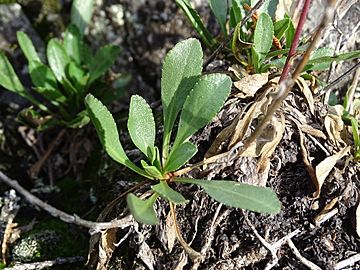Solidago spathulata facts for kids
Quick facts for kids Solidago spathulata |
|
|---|---|
 |
|
| Scientific classification | |
| Genus: |
Solidago
|
| Species: |
spathulata
|
| Synonyms | |
|
Synonymy
Aster candollei Kuntze 1891 not Harv. 1865
Homopappus spathulatus (DC.) Nutt. Solidago simplex var. spathulata (DC.) Cronquist Solidago spiciformis Torr. & A.Gray |
|
The coast goldenrod or dune goldenrod (scientific name: Solidago spathulata) is a beautiful plant found in North America. It belongs to the sunflower family, which is a very large group of flowering plants. This plant is special because it grows mainly along the Pacific Coastal areas of the United States. You can find it in the states of Oregon and California.
Contents
Meet the Coast Goldenrod!
The coast goldenrod is a type of goldenrod plant. These plants are known for their bright yellow flowers, which often bloom in late summer and fall. Solidago spathulata is a smaller goldenrod, making it unique among its relatives. It adds a splash of golden color to the coastal landscapes where it lives.
What Does It Look Like?
The coast goldenrod is a perennial herb. This means it lives for more than two years and grows back each year from its roots. It can grow up to 50 centimeters (about 20 inches) tall. That's about the height of a large ruler! The plant has a special underground stem called a caudex. This caudex helps the plant store energy and survive through different seasons.
The plant's leaves are often shaped like a spoon, which is where its scientific name spathulata comes from. These leaves are usually found near the base of the plant. The stems are strong and hold up many small flowers.
Where Does It Grow?
This goldenrod loves to live near the ocean. Its favorite places are coastal sand dunes. These are sandy hills formed by the wind near beaches. It also grows on hillsides that look out over the Pacific Ocean. The plant is very tough and can handle the sandy soil and salty air found in these coastal areas. Its ability to grow in such places makes it an important part of the coastal ecosystem.
Flowers and Life Cycle
The coast goldenrod produces many small, bright yellow flowers. One single plant can have as many as 100 flower heads! These flowers grow in a branching pattern, making the plant look full and vibrant. Each flower head is actually a cluster of many tiny flowers.
These yellow flowers are very important for pollination. They attract insects like bees and butterflies. These insects help the plant reproduce by carrying pollen from one flower to another. After the flowers are pollinated, they produce tiny seeds. These seeds are then spread by the wind, helping new goldenrod plants grow in other areas. This cycle allows the coast goldenrod to continue thriving along the Pacific coast.



